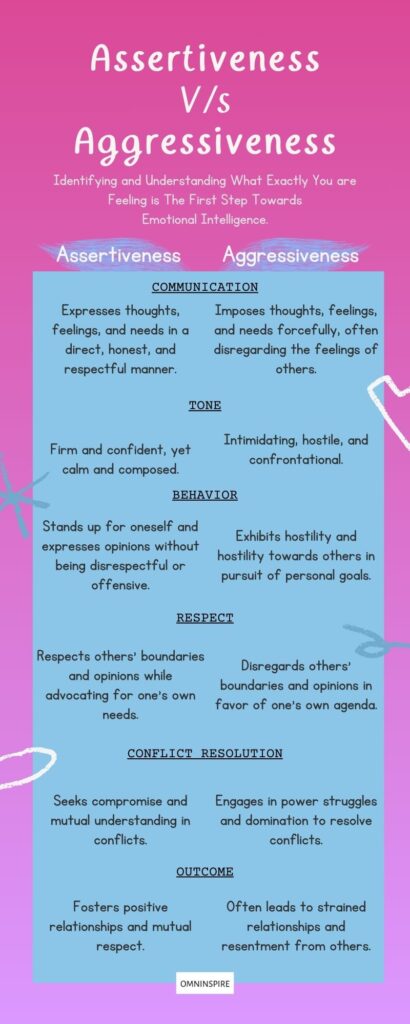Picture Source : Freepik
Edited By : OMNINSPIRE
The common advice that we often give and receive in matters pertaining to workplace, relationships or with raising our children is to “Put your foot down!”. As empowering as this advice sounds, not all implement it the right way. Some think being firm and voicing their opinion is good enough and many think yelling and inciting fear amongst the said parties is the only right way to do it! This is one of may examples where we all confuse assertiveness with being aggressive.
Our aim at OMNINSPIRE is to empower you with the knowledge to better your emotional intelligence. And the first step towards emotional intelligence is to understand what you are feeling and being able to identify exactly what it is that you are feeling. With our ‘Versus‘ articles we try to help you identify the most commonly confused emotions or feeling. Thereby you will be a better judge of your own emotions and will have the wisdom to react accordingly.
In our day to day life, assertiveness and aggressiveness play pivotal roles, in shaping the dynamics of relationships and communication. While both traits involve the expression of one’s needs and desires, they differ significantly in their approach and consequences. Understanding the nuances between assertiveness and aggressiveness is essential for fostering healthy relationships, promoting effective communication, and navigating interpersonal conflicts with grace and integrity.
What is Assertiveness?
Assertiveness is a communication style characterized by the confident and direct expression of one’s thoughts, feelings, and needs, while respecting the rights and boundaries of others. Assertive individuals communicate openly and honestly, without resorting to manipulation or intimidation tactics. They are able to set clear boundaries, say no when necessary, and stand up for their rights in a respectful and constructive manner.
Assertiveness is rooted in self-assurance and self-respect. Assertive individuals value themselves and their opinions, recognizing their worth and entitlement to express themselves authentically. By communicating assertively, individuals can assert their needs, resolve conflicts, and foster mutual understanding and cooperation.
What is Aggressiveness?
Aggressiveness, in contrast, involves the forceful assertion of one’s needs or opinions at the expense of others’ rights or feelings. Aggressive individuals may resort to hostile, confrontational, or manipulative tactics to achieve their goals, often disregarding opposing viewpoints or boundaries. Aggressiveness is driven by a desire for control or dominance, and it can lead to strained relationships, resentment, and conflict escalation.
Unlike assertiveness, which is characterized by confidence and respect, aggressiveness is often rooted in insecurity, fear, or a need for power. Aggressive individuals may use intimidation, coercion, or verbal attacks to assert their dominance, but such tactics ultimately undermine genuine communication and erode trust.
Recognizing the Difference Between Assertiveness and Aggressiveness
Identifying whether you are being assertive or aggressive requires self-awareness, empathy, and mindfulness of your thoughts, emotions, and behaviors. Here are some key indicators to help you distinguish between assertiveness and aggressiveness:

Communication Style:
Assertive communication emphasizes clarity, openness, and respect for others’ viewpoints. When being assertive, individuals express themselves confidently and directly, while also being attentive to the needs and opinions of others. They use language that is firm yet polite, avoiding hostile or confrontational tones.
On the other hand, aggressive communication tends to be confrontational, disrespectful, and dominating. Aggressive individuals may interrupt others, raise their voice, or use threatening language to assert their opinions or demands. They may disregard others’ perspectives and prioritize their own agenda over constructive dialogue.
Emotional Response:
Recognizing your emotional state during interactions is crucial for distinguishing between assertiveness and aggressiveness. Assertive communication is typically associated with feelings of confidence, empowerment, and self-respect. When being assertive, individuals feel secure in expressing their needs and opinions without feeling overly anxious or defensive.
In contrast, aggressiveness often stems from feelings of anger, frustration, or insecurity. Aggressive individuals may lash out in response to perceived threats or challenges, using aggression as a defense mechanism to assert control or dominance. They may experience a heightened sense of tension or agitation during interactions, leading to impulsive or reactive behaviors.
Impact on Others:
Consider how your behavior affects others as a key indicator of assertiveness versus aggressiveness. Assertive communication fosters mutual understanding, cooperation, and trust within relationships. When being assertive, individuals strive to find common ground, respect others’ boundaries, and collaborate towards solutions that benefit everyone involved.
Conversely, aggressiveness may provoke defensiveness, resistance, or hostility in others. Aggressive communication can create a hostile or toxic environment, where individuals feel threatened or disrespected. This can lead to breakdowns in communication, strained relationships, and escalating conflicts.
Through practice and reflection, you can cultivate assertive communication skills that promote mutual respect, understanding, and cooperation in your personal and professional interactions.
Navigating Assertiveness and Aggressiveness
Navigating assertiveness and aggressiveness in interpersonal interactions requires finesse, mindfulness, and a commitment to effective communication. Here’s a detailed elaboration on strategies to help you navigate these emotions and communicate assertively:
#1 Practice Active Listening:
Active listening is a foundational skill for navigating assertiveness and aggressiveness. It involves fully engaging with others’ perspectives, emotions, and needs, demonstrating genuine interest and empathy. When practicing active listening:
- Pay close attention to verbal and nonverbal cues, such as tone of voice, body language, and facial expressions.
- Validate others’ feelings and experiences by paraphrasing or summarizing what they’ve expressed to ensure understanding.
- Ask clarifying questions to delve deeper into their thoughts and feelings, showing a genuine desire to comprehend their perspective.
By actively listening to others, you demonstrate respect, empathy, and a willingness to collaborate, fostering an environment conducive to assertive communication.
#2 Use “I” Statements:
Assertive communication relies on “I” statements to express thoughts, feelings, and needs in a clear, direct, and non-confrontational manner. “I” statements take ownership of one’s emotions and experiences, avoiding blame or accusation directed at others. When using “I” statements:
- Express your thoughts and feelings using phrases like “I feel,” “I need,” or “I think,” followed by a specific description of your emotions or concerns.
- Focus on the impact of behaviors or situations on yourself rather than attributing motives or intentions to others.
- Be specific and concise in your communication, avoiding generalizations or exaggerations that may escalate tensions.
By using “I” statements, you assert yourself assertively while maintaining respect for others’ perspectives and feelings, facilitating constructive dialogue and problem-solving.
#3 Set Boundaries:
Assertiveness involves setting and maintaining clear boundaries to protect your rights, well-being, and personal space while respecting those of others. Establishing boundaries involves:
- Clearly communicating your limits, preferences, and expectations in various situations, whether in personal relationships, professional settings, or social interactions.
- Consistently enforcing boundaries by asserting your needs and values without yielding to manipulation or coercion.
- Recognizing and respecting others’ boundaries by seeking consent, asking for permission, and refraining from behaviors that infringe upon their autonomy or comfort.
Effective boundary-setting fosters mutual respect, trust, and understanding, establishing healthy parameters for communication and interaction.
#4 Stay Calm and Respectful:
Maintaining composure and respect, even in challenging situations, is essential for navigating assertiveness and aggressiveness. When faced with conflict or disagreement:
- Take a moment to pause and collect your thoughts before responding, allowing yourself to respond thoughtfully rather than reactively.
- Use assertive body language, such as maintaining eye contact, standing or sitting upright, and using a calm and even tone of voice.
- Avoid personal attacks, insults, or defensiveness, focusing instead on addressing the issue at hand and finding a resolution.
- Practice empathy by considering the perspectives and feelings of others, even if you disagree with them, and responding with understanding and compassion.
By remaining calm and respectful, you demonstrate emotional intelligence, maturity, and a commitment to constructive communication, de-escalating tensions and fostering positive interactions.
#5 Seek Win-Win Solutions:
Assertive communication aims to find mutually beneficial solutions to conflicts or disagreements, prioritizing collaboration and compromise over domination or control. When seeking win-win solutions.
- Approach conflicts as opportunities for creative problem-solving and collaboration rather than competitions or power struggles.
- Listen actively to the perspectives and concerns of all parties involved, identifying common interests and areas of compromise.
- Brainstorm alternative solutions and strategies that address the needs and priorities of everyone involved, seeking consensus and agreement.
- Focus on building trust, cooperation, and goodwill through transparent communication, mutual respect, and shared goals.
By seeking win-win solutions, you demonstrate a commitment to fairness, respect, and cooperation, fostering positive relationships and outcomes in both personal and professional settings.
By cultivating assertiveness and practicing empathy in our interactions, we can navigate interpersonal relationships with integrity, respect, and authenticity.
And by understanding the difference between assertiveness and aggressiveness and honing our communication skills accordingly, we can foster healthier, more harmonious connections with others, both personally and professionally.





